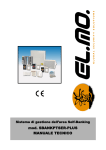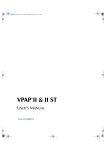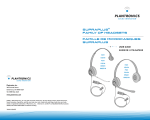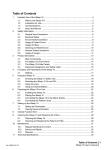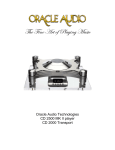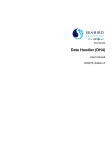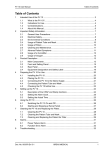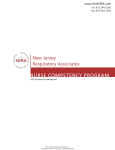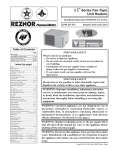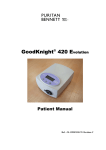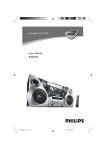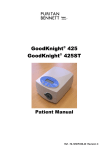Download POLARIS LT c 152``
Transcript
OWNER'S MANUAL POLARIS c152'& POLARIS LT c152'' INVACARE NASAL CPAP SYSTEM SPECIAL NOTES SPECIAL NOTES SPECIAL NOTES DANGER/WARNING/CAUTION notices used in this manual apply to hazards or unsafe practices which could result in personal injury or property damage. NOTICE THE INFORMATION CONTAINED IN THIS DOCUMENT IS SUBJECT TO CHANGE WITHOUT NOTICE. WARNING Do not operate this equipment without first reading and understanding this manual. If you are unable to understand the warnings, cautions and instructions, CONTACT YOUR HOME HEALTHCARE DEALER OR TECHNICAL PERSONNEL IF APPLICABLE BEFORE ATTEMPTING TO USE THIS EQUIPMENT. Otherwise, injury or damage may result. Polaris 2 Part No 1075696 TABLE OF CONTENTS TABLE OF CONTENTS IMPORTANT SAFEGUARDS ..................................................................................... 4 INDICATIONS FOR USE/CONTRAINDICATIONS ............................................... 7 FEATURES .................................................................................................................... 8 SPECIFICATIONS ........................................................................................................ 9 PROCEDURE 1 - INTRODUCTION/INITIAL SETUP .......................................... 10 Treating Obstructive Sleep Apnea ......................................................................................................... 10 Initial Setup ................................................................................................................................................... 10 PROCEDURE 2 - DAILY OPERATION ................................................................... 11 Daily Operation .......................................................................................................................................... 11 Use With Supplemental Oxygen ............................................................................................................ 13 Use In Different Locations ....................................................................................................................... 13 PROCEDURE 3 - MAINTENANCE/ACCESSORIES .............................................. 14 Cleaning and Maintenance ........................................................................................................................ Replacing/Cleaning Air Filter ................................................................................................................... Replacing/Changing Fuse ........................................................................................................................... Accessories .................................................................................................................................................. 14 15 15 16 TROUBLESHOOTING .............................................................................................. 16 NOTES ......................................................................................................................... 18 WARRANTY ............................................................................................................... 19 Part No 1075696 3 Polaris TABLE OF CONTENTS SPECIAL NOTES/WARNINGS .................................................................................. 2 IMPORTANT SAFEGUARDS IMPORTANT SAFEGUARDS IMPORTANT SAFEGUARDS READ ALL INSTRUCTIONS BEFORE USING. Caution: Federal law (USA) restricts this device to sale by or on the order of a physician. When using electrical products, especially when children are present, basic safety precautions should always be followed, including the following: TO REDUCE THE RISK OF ELECTROCUTION DANGER ALWAYS unplug this product IMMEDIATELY after using. DO NOT use while bathing. DO NOT place or store product where it can fall or be pulled into a tub or sink. DO NOT reach for product that has fallen into water. UNPLUG IMMEDIATELY. DO NOT place or drop into water or other liquid. Risk of electric shock. DO NOT disassemble. Refer servicing to qualified service personnel. TO REDUCE THE RISK OF BURNS, ELECTROCUTION, FIRE, OR INJURY TO PERSONS WARNING Close supervision is necessary when this product is used near CHILDREN or by PHYSICALLY CHALLENGED INDIVIDUALS. Use this product only for its intended use as described in this manual. Use this product only under physicians direction. DO NOT use attachments not recommended by the manufacturer. NEVER operate this product with a damaged cord or plug, if it is not working properly, if it has been dropped or damaged, or dropped into water; call Qualified Service Personnel for examination and repair. Keep the cord away from HEATED or HOT surfaces. NEVER drop or insert any object into any opening or hose. NEVER block the air openings of the product or place it on a soft surface, such as a bed or couch, where the air openings may be blocked. Keep the air openings free from lint, hair and the like. Blocked openings may cause the unit to shut down. Contact dealer immediately. This unit is oil-less. DO NOT lubricate. RADIO FREQUENCY INTERFERENCE CAUTION Most electronic equipment is influenced by Radio Frequency Interference (RFI). CAUTION should be exercised with regard to the use of portable communication equipment in the area around such equipment. SAVE THESE INSTRUCTIONS Polaris 4 Part No 1075696 IMPORTANT SAFEGUARDS IMPORTANT SAFEGUARDS GENERAL WARNINGS This device is NOT intended for invasive application. EXPLOSION HAZARD - DO NOT use in the vicinity of flammable anesthetics. GENERAL WARNINGS OXYGEN USE Oxygen is a prescription gas and should be used only under the supervision/ direction of a physician. Should you require oxygen during CPAP therapy, refer to your oxygen system manual and observe all cautions/warnings regarding safe use of oxygen. Oxygen vigorously supports combustion. DO NOT smoke or have an open flame in any room where oxygen is used. The oxygen flow MUST be turned off when the device is not operating so as not to accumulate oxygen within the device and tubing which may create a risk of fire. SPECIFIC WARNINGS RELATED TO TREATMENT The Invacare CPAP unit is designed to treat Obstructive Sleep Apnea. However, you need to be aware of possible problems that may arise during the course of nasal CPAP treatment. If you have concerns about any of these problems consult your physician immediately. You may experience sneezing, a runny nose or nasal obstruction, especially during the first few weeks of using your nasal CPAP system. This may necessitate treatment such as a nasal spray. Consult your physician for advice. NOTE: The use of aromatic additives such as eucalyptus oil, tea tree oil or mentholated ointments may cause deterioration of the mask system when components are in direct contact. These additives may be flammable and therefore MUST NOT be used when supplemental oxygen is in use. If you experience any of the following symptoms during the course of your CPAP treatment, consult your physician immediately: Headache Middle ear or sinus discomfort Chest pain Feeling slightly bloated. This is usually the result of swallowing excessive amounts of air in response to the pressure sensation from your CPAP system while you are awake. Using the delay timer may help, but contact your physician if symptoms persist. Dryness of the nose, mouth or throat. The use of a humidifier may help. Contact your physician or equipment supplier regarding the types of humidifier that can be used with the Invacare CPAP unit. Air continually leaking out of the mouth while sleeping. DO NOT stop your CPAP treatment without consulting your physician. Part No 1075696 5 Polaris IMPORTANT SAFEGUARDS THIS IS NOT A LIFE SUPPORT DEVICE. It may stop operating with a power interruption or if a fault occurs in the product. IMPORTANT SAFEGUARDS IMPORTANT SAFEGUARDS IMPORTANT SAFEGUARDS SPECIFIC WARNINGS RELATED TO TREATMENT (CONTINUED) Always consult your physician if you expect to be in a situation where you cannot use your CPAP system for more than a few days. If any of the symptoms of sleep apnea recur during the course of your CPAP treatment, consult your physician. If you are admitted to a hospital or are prescribed any other form of medical treatment, always inform the medical staff that you are being treated with nasal CPAP. Make sure that your physician who is treating you for sleep apnea is contacted. Skin irritation may occur from sensitivity to the material in the mask or from too much tension in the headgear straps. A correctly fitted mask and optimum tension in the headgear straps will often prevent skin irritation. If problems persist, contact your physician or equipment supplier for advice. If you experience an infection of the upper respiratory tract, middle ear or sinus, you should consult your physician before continuing your CPAP treatment. You may be advised to stop CPAP treatment until the infection has cleared. If you continue with CPAP treatment during an infection, it is advisable to wash your mask and tubing more often. The INVACARE Nasal CPAP system should be used only with masks (and connectors)* recommended by the manufacturer of the CPAP machine, or by your physician or respiratory therapist. A nasal mask should not be used unless the CPAP machine is turned on and operating properly. The vent holes associated with the mask should never be blocked. Explanation of the Warning: This CPAP machine is intended to be used with special masks (or connectors)* which have vent holes to allow continuous flow of air out of the mask. When the CPAP machine is turned on and functioning properly, new air from the CPAP machine flushes the exhaled air out through the mask vent hole. However, when the CPAP machine is not operating, enough fresh air will not be provided through the mask, and exhaled air may be rebreathed. Rebreathing of exhaled air for longer than several minutes can in some circumstances lead to suffocation. This warning applies to most models of CPAP machines. * Ports may be incorporated in the mask or in connectors that are near the mask. At low pressures, the flow through the exhalation ports may be inadequate to clear all exhaled gas from the tubing. Some rebreathing may occur. The air flow temperature for breathing produced by this device can be as much as 11°F (6°C) higher than the temperature of the room. Caution should be exercised if the room temperature is warmer than 104°F (39°C). DO NOT open the CPAP unit case or attempt to adjust the unit. Polaris 6 Part No 1075696 INDICATIONS FOR USE/CONTRAINDICATIONS INDICATIONS FOR USE/CONTRAINDICATIONS INDICATIONS FOR USE TM The Invacare Polaris Nasal CPAP system delivers Continuous Positive Airway Pressure (CPAP) for the treatment of Obstructive Sleep Apnea (OSA) in adults. Your Home Healthcare provider or clinician will adjust your unit to the correct pressure settings based on your specific condition and system accessories. CONTRAINDICATIONS Nasal CPAP therapy should be used under the supervision of a licensed physician. The following conditions contraindicate the use of Nasal CPAP for some patients: 1. Existing respiratory failure or insufficiency resulting in poten tial risk of rebreathing. 2. Pneumothorax or pneumomediastinum. 3. Bullous lung disease. 4. Untreated cardiac failure or hypotension. 5. Massive epistaxis or previous history of massive epistaxis (nose bleed). 6. Pneumoencephalus, recent trauma or surgery that may have produced cranionasopharyngeal fistula. 7. Acute sinusitis, otitis media or perforated ear drum. The clinician should assess on a case by case basis the relative risks and benefits of nasal CPAP therapy in such a subject. When assessing the relative risks and benefits, the clinician should understand that the Invacare CPAP system can deliver pressures up to 18 cmH2O. Also in the unlikely event of certain fault conditions, a maximum static pressure of 27cmH2O is possible. If such a pressure could present risk to particular patients, then this device MUST NOT be used. Part No 1075696 7 Polaris IMPORTANT SAFEGUARDS IMPORTANT INFORMATION FEATURES FEATURES FEATURES INVACARE POLARISTM / POLARIS LTTM NASAL CPAP SYSTEM (FIGURE 1) You should take time to become familiar with the features of your Invacare Polaris/Polaris LT Nasal CPAP System (FIGURE 1). It is equipped with a built-in tubing holder in the top of the machine (as shown). This is a convenient place to store the tubing when not in use, and will aid in keeping the mask clean and undamaged. For details on the range of accessories available, refer to the MAINTENANCE/ACCESSORIES in PROCEDURE 3 of this manual. NOTE: If the device or any of the system components are missing or damaged, DO NOT use. Contact your home healthcare provider. NOTE: A mask and headgear are needed in order to use this system. Ramp/Therapy Delay Button Reusable/Replaceable Filter 6 ft. Tubing Mode Indicators AC Power Connector Air Outlet Numeric Display (Model ISP9800 ONLY) On/Off Switch Fuse Cover and Holder AC Power Cord FIGURE 1 - INVACARE NASAL CPAP SYSTEM/FEATURES Polaris 8 Part No 1075696 SPECIFICATIONS SPECIFICATIONS AND SUPPLEMENTAL INFORMATION, MODELS ISP9800, ISP9900 TM INVACARE POLARIS NASAL CPAP SYSTEM SYMBOL IDENTIFICATION: Attention - Consult accompanying documents Class II equipment, Double Insulation Type BF equipment IPX 1 Protected against dripping water Fuse Alternating Current (AC) Stand By Indicator Ramp/Therapy Delay Indicator cmH2O PERFORMANCE Operating Pressure Range: Ramp: Centimeters of Water, Therapy Pressure Indicator 3-18 cmH2O Model ISP9900 - 0, 20 minutes Model ISP9800 - 0, 5, 10, 20 and 30 minutes DIMENSIONS: 5.6 x 8.9 x 10.2 - inches (14.2 x 22.6 x 25.9 cm) WEIGHT: <5 lbs. (2.27 kg.) POWER SUPPLY Input Range: 110-240 VAC, 50-60 Hz AIR FILTER Standard Filter: 45-60 ppi foam, reusable FUSE 115V and 230V use: ENVIRONMENTAL RATINGS Temperature Limits: 1A, 250VAC, Quantity 2 Operating: 50° F to 104° F (10°C to 40°C) Storage: -4°F to 158° F (-20° C to 70° C) Humidity: Operating: 15 to 95% RH (non-condensing) Storage: up to 95% RH (non-condensing) Altitude: -300 to 6,000 ft. (-90 to 1830m) AIR TUBING Flexible Plastic: REGULATORY LISTING: 6 ft. (2m approx.) In compliance with UL1431 Personal Hygiene and Health Care appliances, CSA C22.2 No. 68-92 Motor Operated Appliances (Household and Commercial), and UL 1097 Double Insulation Systems for use in Electrical Equipment. NOTE: The manufacturer reserves the right to change these specifications without notice. Part No 1075696 9 Polaris SPECIFICATIONS Power OFF (disconnection from the mains) Power ON (connection to the mains) INTRODUCTION / INITIAL SETUP PROCEDURE 1 INTRODUCTION/INITIAL SETUP TREATING OBSTRUCTIVE SLEEP APNEA INTRODUCTION Obstructive Sleep Apnea or OSA is a condition in which the airways become blocked during sleep, cutting off the brains supply of oxygen. HOW CPAP TREATMENT WORKS In CPAP treatment, a flow generator provides air through a nose mask at a slightly raised pressure which keeps the airway open. A filter at the air inlet traps dust and airborne particles so that the air you breathe through the mask should be cleaner than the air in the room. This pressure varies according to individual needs. Your physician will prescribe your set pressure which is determined during a sleep study and set by the sleep center staff or your equipment supplier. If you find the initial sensation of pressure uncomfortable while trying to fall asleep you may use the therapy delay timer. This allows the air pressure in your mask to build up gradually over time to your set pressure. You will have the comfort of a relatively low pressure while still awake and the assurance that the required pressure will be reached shortly after you fall asleep. Refer to USING THE THERAPY DELAY in PROCEDURE 2 of this manual, for instructions on use. Your physician may advise against using this feature if a delayed start would not be beneficial for you. Your Invacare Nasal CPAP system is normally used at home, but it may also be taken with you when you travel. The CPAP unit can operate on power supplies in other countries without any special adjustment. NOTE: See USE IN DIFFERENT LOCATIONS Section in PROCEDURE 2 of this manual. If you feel that you are no longer getting relief from your symptoms of sleep apnea, consult your physician. INITIAL SETUP Your home healthcare provider has provided you with a mask and headgear to be used with your CPAP unit. 1. Place the unit and accessories in a stable, clean, dry location within reach of an electrical outlet. NOTE: Placing the unit on a night stand is preferred to minimize dust in the air. 2. Make sure unit is close enough to your bed to allow slack in the tubing between you and CPAP unit while sleeping. NOTE: Do not use extension cords or electrical adaptors. 3. Position the CPAP unit so that the intake vents at the rear of the unit are not obstructed. 4. Make sure the power switch is in the OFF position. 5. Connect the power cord to the AC power connector at the rear of the unit. Plug the other end of the power cord into the electrical outlet. 6. Connect one end of the tubing to the CPAP unit air outlet, and the other end to the mask. Assemble the mask and headgear according to the instructions provided. All masks are equipped with exhalation ports which should never be blocked. Refer to mask instruction/healthcare provider for further information. WARNING DO NOT leave long lengths of tubing around the top of the bed or pillow which could twist around your head or neck while sleeping. Polaris 10 Part No 1075696 I N T R O D U C T I O N / I N I T I A L S E T U P PROCEDURE 2 DAILY OPERATION DAILY OPERATION DAILY OPERATION (FIGURE 1) NOTE: To prolong the life of your particular mask cushion, it is recommended you wash your face to remove excess facial oils prior to fitting the mask. 1. Connect the air tubing to the mask frame and CPAP unit. 2. Turn the CPAP unit ON using power switch at the rear of the unit. All the icon lights will light up and then go off. Next, the run time hours and compliance hours will briefly be displayed. The cmH2O icon will illuminate and the numeric pressure display will read the prescribed pressure. Ramp/Therapy Delay Icon Invacare Button cmH2O Icon Standby Icon Numeric Display (ISP9800 ONLY) FIGURE 1 - DAILY OPERATION 3. Fit the mask with headgear and tubing to your face and adjust as needed. NOTE: A minor leak around the lower part of the face is sometimes preferable to overtightening the mask. However, any air leaks blowing in the direction of the eyes should be eliminated as this may cause eye irritation. 4. Settle down in bed and adjust the tubing by either running the tubing over the top of the headboard or running the tubing across your shoulders. NOTE: Try both ways and see which is more comfortable. 5. Set the final tension of the headgear straps while lying down. NOTE: The pressure will rise quickly to the set pressure as prescribed by your physician and set by your home healthcare provider/clinician. 6. If a therapy delay has not been prescribed, each push of the Invacare button atop the unit will alternate the CPAP unit between standby mode and normal therapy delivery. For Standby Mode, the Invacare button can be used if you wake up in the middle of the night and need to TEMPORARILY stop and restart the CPAP unit. WARNING A nasal mask should not be worn unless the CPAP unit is turned ON and working properly. A nasal mask should not be worn while the CPAP unit is in Standby Mode. 7. When you awaken and are through using the unit, remove the mask and turn the unit OFF using the power switch in the rear of the unit. Part No 1075696 11 Polaris DAILY OPERATION NOTE: Prior to each use, inspect the CPAP unit, tubing and mask for damage, failure or worn parts. Contact provider if evidence is present. PROCEDURE 2 DAILY OPERATION USING THE THERAPY DELAY DAILY OPERATION If your physician prescribed a therapy delay, a gradual build up of air pressure while falling asleep, your home care provider will be able to set this feature on your CPAP unit. The delay timer can be set to (ISP9800 ONLY: 0, 5, 10, 20 or 30 minute or ISP9900 ONLY: 0 or 20 minute) build up to prescribed pressure. 1. Follow STEPS 1-5 in the DAILY OPERATION section. 2. Push the INVACARE button on top of the CPAP unit once. The cmH2O icon and the numerical display will go off and the therapy delay icon will light up. The pressure delivered by the CPAP unit will decrease. The CPAP unit will now gradually increase in delivered pressure while you fall asleep. The prescribed pressure will be displayed once it is reached. 3. If the Invacare button is pushed a second time, the CPAP unit will go into standby mode, causing the blower to stop. The standby icon will light up. NOTE: Each push of the INVACARE button will cycle the unit between therapy delay and standby mode. Turning the unit OFF and back ON with the power switch will automatically place the unit back in normal therapy delivery. 4. When you awaken and are through using the unit, remove the mask and turn the unit OFF using the power switch in the rear of the unit. HELPFUL HINTS, PATIENT USE Some people experience a continuing dryness of the nose, mouth or throat when on nasal CPAP, particularly during the winter months. Invacare offers a range of humidifiers to relieve these symptoms. You should contact their physician or equipment supplier for specific advice on whether these are suitable for you. Remember, tight fit of the mask is not necessary. A well-balanced, comfortable fit without being too tight will still provide an efficient air seal. Pulling the headgear straps too tight can lead to sensitivity of the bridge of the nose or the upper lip, and occasionally skin irritation. If you are having a continuing problem with obtaining a comfortable and secure fit with the nose mask, do not hesitate to contact your healthcare provider. They may be able to improve the cushion fit, or suggest an alternative size/style of mask or headgear from the wide range now. HELPFUL HINTS, GENERAL When nasal CPAP is used for the first time, you will notice an unusual sense of pressure when breathing. You will need to consciously push out when you exhale. This is normal and will occur automatically when you are asleep. Taking a few deep breaths when you start treatment may help you adjust to the sensation. While wearing the mask, you should keep your mouth closed and not try to talk. If you open your mouth, air will leak out. This may feel a little unpleasant. When asleep, your mouth usually stays closed automatically. However, if you awake at night and open your mouth, the sensation of air rushing from your mouth might alarm you at first. The THERAPY DELAY feature can be useful in helping to overcome these problems. The pressure will build up gradually from a more comfortable level to the prescribed setting. Polaris 12 Part No 1075696 DAILY OPERATION PROCEDURE 2 USE WITH SUPPLEMENTAL OXYGEN When using oxygen with the Invacare Nasal CPAP system: 1. Ensure the oxygen gas is turned OFF. 2. Connect the oxygen supply tubing to the mask port or T-fitting adapter. Refer to mask instructions for use. 3. Connect the air tubing to the mask frame/adapter and CPAP unit. 4. Turn the CPAP unit ON (Power Button, rear of unit). 5. Turn the oxygen supply ON according to setting prescribed by your physician. 6. Fit the mask with headgear/tubing to your face and adjust as needed. 7. Refer to DAILY OPERATION in this procedure of the manual for use. 8. When through using the unit, remove the mask, turn the oxygen source OFF, and then turn the unit OFF (Power Button, rear of unit). WARNING The oxygen flow MUST be turned off when the device is not operating so as not to accumulate oxygen within the device and tubing which may create a risk of fire. NOTE: At a fixed flow rate of supplemental oxygen flow, the inhaled oxygen concentration will vary, depending on the pressure settings, patient breathing pattern, mask selection, and the leak rate. USE IN DIFFERENT LOCATIONS The Invacare CPAP unit will operate on the different power supplies in other parts of the world. The unit accepts 110-240 VAC, 50-60 Hz. No special adjustment to the unit is necessary but the correct adapter for the type of power outlet in the country you are visiting should be used. Contact your home healthcare provider for information on a suitable adapter. Always remember to pack the detachable power cord with the rest of the equipment when traveling. Adapters for the power cord for use in different countries are not supplied with this product. NOTE: The Invacare CPAP model ISP9800 unit AUTOMATICALLY compensates for changes in altitude. No adjustment to your pressure setting is required when traveling within the altitude range stated in the SPECIFICATION Section in this manual. For locations outside of the altitude range, see your provider for pressure setting adjustments. NOTE: The Invacare CPAP model ISP9900 unit DOES NOT automatically compensate for changes in altitude. See your provider for pressure setting adjustments when traveling to locations with elevations that are greater than 3000 ft. from the elevation of primary use. In locations where AC line voltage is unavailable, use of an inverter will allow the unit to operate from a battery. The inverter (DC to AC) will need a capacity of 100W or more to ensure proper unit operation. Part No 1075696 13 Polaris DAILY OPERATION Oxygen is a prescription gas and should be used only under the supervision/direction of a physician. Should you require oxygen during CPAP therapy, refer to your oxygen system manual and observe all cautions/warnings regarding safe use of oxygen. PROCEDURE 3 MAINTENANCE/ACCESSORIES MAINTENANCE WARNING MAINTENANCE DO NOT attempt to open the CPAP unit. Inspection and repair should only be performed by your Home Healthcare dealer, or qualified service personnel. CLEANING AND MAINTENANCE Your Invacare CPAP unit is designed to give years of trouble-free operation. It is not necessary to send your unit away for regular servicing provided you follow these recommendations. WARNING The entire nasal mask system, including the air tubing, is for single patient use, and must not be reused on another person. This is to avoid the risk of cross-infection. Unplug the unit before cleaning it and let it dry completely before plugging it in or operating it. CAUTION DO NOT immerse the unit or power cord in water as serious damage could result. DO NOT drop or insert any objects into the air tubing or air outlet on the CPAP unit. DO NOT hang the air tubing in direct sunlight as the tubing may harden over time and eventually crack. DO NOT use bleach, chlorine-, alcohol-, or aromatic-based solutions to clean the cushion, mask or air tubing. These solutions may cause hardening and reduce the life of the product. DO NOT allow water from a humidifier to spill through the air tubing into the CPAP unit. This may result in failure of the motor. (Damage so caused is not covered under warranty.) NOTE: You should regularly carry out the cleaning and maintenance described in this section and/or the literature provided with your particular mask and headgear. DAILY 1. After daily use, wipe the inside and outside of the mask frame and nasal cushion with a clean, damp cloth. 2. Disconnect the air tubing at the CPAP unit and hang the tubing and mask in a clean, dry place until next use. 3. If using a humidifier, remove the short air tubing between it and the CPAP unit after each use and follow the manufacturers cleaning and maintenance schedule. 4. Clean and maintain the humidifier in accordance with the operating manual supplied with it. Polaris 14 Part No 1075696 MAINTENANCE/ACCESSORIES PROCEDURE 3 MAINTENANCE (Continued) PERIODICALLY 2. Replace the forehead pads if they are soiled or worn (about every three to six months). 3. Check that the air outlet vent on the mask frame is not blocked. Remove any obstruction with a pin or similar object. NOTE: All items of the mask and air tubing system are subject to normal wear and tear and may eventually need to be replaced. Check periodically for excessive wear in these items. 4. Clean the exterior of the CPAP unit when necessary with a damp cloth and mild dishwashing detergent. REPLACING/CLEANING THE AIR FILTER 1. The Invacare CPAP unit is supplied with a reusable filter. This filter can be removed from the rear of the unit by pulling it directly out of the filter receptacle. 2. The filter should be washed thoroughly with mild soap and water solution, rinsed thoroughly and allowed to dry completely before use. NOTE: The filter should be washed monthly or as needed. NOTE: Dry on dish rack or squeeze between paper towels. NOTE: The filter is subject to normal wear and tear and should be replaced every six (6) months. Check periodically for excessive wear. 3. The filter is returned to the unit by pressing it against the filter receptacle and tucking the edges into place. Should you feel that your unit is not performing properly, check the TROUBLESHOOTING section of this manual. If there is still a problem, contact your equipment supplier or sleep disorders center. REPLACING/CHANGING THE FUSE The Invacare CPAP unit is equipped with two (2) fuses which may need to be replaced when the unit does not power up when turned on. The fuses are located at the back of the unit next to the power AC connector. When replacing the fuses, be sure to unplug the unit and replace only with fuses of the same type and rating as specified in the Specification section of this manual. (For your convenience, Invacare offers fuse replacement packs. Contact your home healthcare provider for parts.) 1. Unplug the AC power cord from the back of the Nasal CPAP unit. 2. Use a small screwdriver to lift the fuse cover on the power module (next to the ON/OFF switch [rear of unit]). 3. Use the screwdriver to lift the fuse holder out of the unit. 4. Replace both fuses. 5. Insert the fuse holder into the unit and snap the cover back into place. Part No 1075696 15 Polaris MAINTENANCE 1. Wash the headgear, mask frame, cushion and air tubing in warm water using a mild detergent. Rinse thoroughly (particularly the air tubing) and allow to drip dry. ACCESSORIES ACCESSORIES ACCESSORIES/ TROUBLESHOOTING ACCESSORIES Invacare offers a wide range of accessories and replacement parts for use with the Polaris CPAP unit. These include: A variety of masks and headgears, styles and sizes. Heated and non-heated humidifiers. Standard and fine-particle filters (i.e. to filter out small particulates including pollens). Tubing Contact your Home Healthcare Provider for further information about these and other items. Likewise, your Home Healthcare Provider can provide information on availability, cost, and delivery arrangements of any spare parts your Invacare Nasal CPAP unit may require. TROUBLESHOOTING If you have any problems with your Invacare Nasal CPAP System, try the following suggestions. If it is still not working properly, consult your equipment supplier or take it to an authorized service agent. Do not attempt to open the CPAP unit. PROBLEM POSSIBLE CAUSE SOLUTION Display lights do not illuminate 1. Power cord NOT connected 1. Turn power switch at rear of unit (Unit does NOT come on). firmly and/or power switch at OFF. Unplug power cord at both rear of unit OFF. ends and reconnect firmly. Turn unit back on. Insufficient air delivered from CPAP unit. 2. Power outlet may be faulty. 2. Try another power outlet. 3. Unit malfunction. 3. Turn power switch at rear of unit OFF. Wait several seconds, turn unit back on. If unit does NOT operate, contact Home Healthcare provider. 1. Therapy Delay function is in 1. Wait for air Pressure to come on use. gradually, according to the selected delay period. (Refer to the DAILY OPERATION Section of this manual). Check if light lit up. To go to full pressure, turn off and back on again at rear of unit. 2. Dirty air filter. 2. Clean or Replace if dirty. (Refer to the MAINTENANCE Section of this manual.) 3. Air tubing is kinked or punctured. 3. Straighten or replace tubing. 4. Air tubing is not connected 4. Tighten air tubing connections at properly. both ends. Polaris 16 Part No 1075696 TROUBLESHOOTING TROUBLESHOOTING (CONT.) PROBLEM POSSIBLE CAUSE SOLUTION Air leaking around nose and eyes. 1. Plugs are missing from access 1. Replace plugs. ports in mask. 2. Mask and headgear straps not 2. Adjust position of mask and positioned correctly. headgear straps. (Refer to the INITIAL SETUP Section of this manual). 3. Nasal cushion is torn or distorted. 3. Replace cushion. Therapy delay not functioning as you expect. Your clinician may not have pro- If unit only operates in standbyor normal therapy mode,call physician vided for a delay time. and request delay time. ISP9800 - Display reads E132 at startup. 1. Stuck Invacare button. ISP9900 - All three green LED's are flashing. 2. Buttons held down at startup. 2. Release all buttons. Turn unit OFF and ON at rear switch. Wait for unit to come on before pressing any buttons. ISP9800 - Display reads EXXX and device is inoperative. Internal device error. 1. Check button and correct if stuck. Turn unit OFF and ON at rear switch. Contact Home Healthcare Provider immediately. ISP9900 - All three green LED's are flashing after performing solution steps 1 & 2 for stuck/held down button noted above. Part No 1075696 17 Polaris TROUBLESHOOTING T R O U B L E S H O O T I N G NOTES NOTES Polaris 18 Part No 1075696 WARRANTY WARRANTY PLEASE NOTE: THE WARRANTY BELOW HAS BEEN DRAFTED TO COMPLY WITH FEDERAL LAW APPLICABLE TO PRODUCTS MANUFACTURED AFTER JULY 4, 1975. WARRANTY This warranty gives you specific legal rights and you may also have other legal rights which vary from state to state. Invacare Respiratory warrants the Nasal CPAP System to be free from defects in materials and workmanship for a period of two (2) years from date of purchase. If within such warranty period any such product shall be proven to Invacares satisfaction to be defective, product shall be repaired or replaced, at Invacares option. This warranty does not include normal wear and tear or shipping charges incurred in replacement part installation or repair of such product. Invacares sole obligation and your exclusive remedy under this warranty shall be limited to such repair and/ or replacement. For warranty service, please contact Invacare Respiratory Service Department at the Toll Free Number listed (Back Cover) during normal hours. Upon receiving notice of an alleged defect in a product, Invacare will issue a serialized return authorization. It shall be the responsibility of the purchaser to return, at the purchasers cost, to either Invacares plant or service center as specified by Invacare Respiratory in advance. Defective components part(s) must be returned for warranty inspection using the serial number for identification within 30 days of the return authorization date. DO NOT return products to our factory without prior consent. C.O.D. shipments will be refused - please prepay shipping charges. Limitations and Exclusions: The foregoing warranty shall not apply to serial numbered products if the serial number has been removed or defaced, products subjected to negligence, accident, improper operation, maintenance or storage, products modified without Invacares express written consent (including, but not limited to, modification through the use of unauthorized parts or attachments; products damaged by reason of repairs made to any component without the specific consent of Invacare, or to a product damaged by circumstances beyond Invacares control, and such evaluation will be solely determined by Invacare. The warranty shall not apply to problems arising from normal wear or failure to adhere to these instructions. THE FOREGOING WARRANTY IS EXCLUSIVE AND IN LIEU OF ALL OTHER EXPRESS WARRANTIES. IMPLIED WARRANTIES, IF ANY, INCLUDING THE IMPLIED WARRANTIES OF MERCHANTABILITY AND FITNESS FOR A PARTICULAR PURPOSE, SHALL NOT EXTEND BEYOND THE DURATION OF THE EXPRESSED WARRANTY PROVIDED HEREIN AND THE REMEDY FOR VIOLATIONS OF ANY IMPLIED WARRANTY SHALL BE LIMITED TO REPAIR OR REPLACEMENT OF THE DEFECTIVE PRODUCT PURSUANT TO THE TERMS CONTAINED HEREIN. INVACARE SHALL NOT BE LIABLE FOR ANY CONSEQUENTIAL OR INCIDENTAL DAMAGES WHATSOEVER. Some states do not allow the exclusion or limitation of incidental or consequential damage, or limitation on how long an implied warranty lasts, so the above exclusion and limitation may not apply to you. This warranty shall be extended to comply with state/PROVINCIAL laws and requirements. Part No 1075696 19 Polaris WARRANTY This warranty is extended only to the original purchaser/user of our products. Invacare Corporation www.invacare.com USA Canada 570 Matheson Blvd E Unit 8 Mississauga Ontario L4Z 4G4 Canada 800-668-5324 One Invacare Way Elyria, Ohio USA 44036-2125 800-333-6900 Invacare, Polaris, and Polaris LT are registered trademarks of Invacare Corporation. Yes, you can. is a trademark of Invacare Corporation. © 2002 Invacare Corporation Part No. 1075696 Rev F 07/02





















